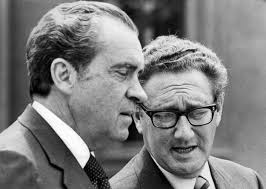The Nixon administration decided to keep mum when it received the first formal request for US recognition of Bangladesh in June 1971 and announced support for a unified Pakistan.
Dated “Mujibnagar”, April 24, the letter requested President Richard Nixon’s immediate US recognition of the “sovereign independent People’s Republic of Bangladesh” and establishing diplomatic relations with the Bangladesh government which was “exercising full sovereignty and lawful authority within the territories known as East Pakistan prior to March 26, 1971”.
The letter was signed by Syed Nazrul Islam, the acting president, and Khandakar Moshtaque Ahmed, the foreign minister, of the provisional government.
Also attached were the “Proclamation of Independence” dated April 10, a proclamation by Syed Nazrul Islam continuing East Pakistan laws in force in Bangladesh, and the list of cabinet members, including President Sheikh Mujibur Rahman, according to a declassified document of the State Department.
The document “made it difficult” for the US to “continue to take a public line that it never received any request for recognition of the State of Bangladesh.”
The US finally recognized Bangladesh on April 4, 1972.
The document reached Washington in June in regular international air mail from West Berlin, postmarked May 26 with no return address.
What did the US say
On June 22, 1971, Secretary of State William P Rogers sent a response to the letter to the Embassy in Pakistan. The telegram was drafted on June 17.
Rogers said that even though the method of transmittal raised questions, it was the first formal request from officials of the Bangladesh movement for US recognition with “sensitive political implications”.
He said the US “of course continues to consider East Pakistan part of State of Pakistan which we recognize”, and to counsel the Pakistan government “with whom we maintain diplomatic relations to develop political solution to present troubles”.
Hence, the State Department decided not to make any acknowledgement of the document and asked the Pakistan Embassy to continue to say that the US considers the territory of East Pakistan to be part of the State of Pakistan.
Rogers also suggested a formal response for the embassy if it is asked about a request to recognize Bangladesh. “We have received through international air mail a letter mailed from Berlin without return address which purported to ask for recognition of the ‘People’s Republic of Bangladesh’. It would be inappropriate for us to take any action with respect to it since we consider the territory of East Pakistan to be part of the State of Pakistan,” read the telegram.
War situation
The Mujibnagar government was formed with people’s representatives elected in the 1970 national election, under the leadership of Bangabandhu, who was taken to West Pakistan following his arrest on March 25. Tajuddin Ahmed was the prime minister.
During this time, the Pakistani military junta was carrying out genocide under “Operation Searchlight” on its eastern front to suppress a Bengali struggle for liberation. The targeted killings of Bengalis, especially AL men and Hindus, in Dhaka and other towns by the military and their local collaborators led to an exodus of refugees to India. At the same time, many youths crossed the border for guerrilla training.
This angered Pakistani military ruler, General AM Yahya Khan. On May 22, he said the refugees could come back, but in the three weeks since then, an additional two million crossed into India, taking the official tally to 5,923,439. Around 90% of the refugees were Hindus.
Gen Yahya also claimed he was ready to accept part of the Six-Point Charter of the Awami League to reach a political solution and hand over power to a civilian government sans Sheikh Mujib and other top leaders.
On the other hand, a Special Military Court-1 in Dhaka on June 8 convicted Tajuddin Ahmad, Tofail Ahmed, Syed Nazrul Islam, Abdul Mannan, and the editor of the daily Peoples Abidur Rahman on account of treason in their absence. They were delivered a punishment of 14 years of imprisonment and forfeited 50% of their assets.
Indian Prime Minister Indira Gandhi threatened her counterpart with tough action had he not stopped the flow of refugees, shunned the path of massacre, and chosen a political solution to the crisis by freeing Sheikh Mujib.
The tension escalated in late May when the US anticipated that a war could break out between the South Asian neighbours when its ally Pakistan would not survive more than a few weeks if attacked on East and West fronts.
At that time, the Nixon administration asked India to exercise restraint and threatened aid cuts, and made sure Gen Yahya was happy. He was helping the US restore diplomatic ties with China.
For example, a week after the Indian foreign minister met with Nixon in Washington, The New York Times on June 22 reported that two Pakistani freighters were preparing to sail with cargos of military equipment for Pakistan. State Department officials maintained that no export licenses for military equipment had been issued since March 25.
The Embassy in New Delhi reported that news of the arms shipments had shocked the Indian government and prompted angry scenes in both houses of parliament. On June 27, the Indian Embassy delivered a note to the Department of State formally protesting the shipments and urging that steps be taken to prevent the shipments from reaching Pakistan.


মন্তব্য করুন
মন্তব্য করার জন্য আপনাকে অবশ্যই লগইন করতে হবে।